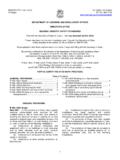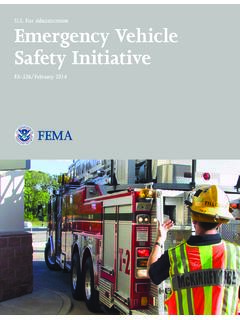Transcription of PERSONAL PROTECTIVE EQUIPMENT STANDARD …
1 APRIL 2014 1 Environmental Health and Safety PERSONAL PROTECTIVE EQUIPMENT STANDARD OPERATING PROCEDURE (SOP) I. Purpose, Applicability, and Scope a. Purpose- This policy provides guidelines to ensure the proper selection, use, and care of PPE through work area hazard assessments and appropriate employee training. b. Applicability- This policy applies to all employees and students on the TTU campus. This procedure is also applicable to TTU employees and students who are engaged in off-site, university-sponsored activities. c. Scope- This procedure applies to hazards that require the use of PROTECTIVE apparel , also known as PERSONAL PROTECTIVE EQUIPMENT . II. Abbreviations, Acronyms, and Definitions a. Abbreviations ANSI: American National standards Institute EHS: Environmental Health and Safety NIOSH: National Institute of Occupational Health and Safety OSHA: Occupational Safety and Health Administration PPE: PERSONAL PROTECTIVE EQUIPMENT TOSHA: Tennessee Occupational Safety and Health Administration b.
2 Definitions Hazard Assessment: Identification of physical and chemical hazards in the workplace. PERSONAL PROTECTIVE EQUIPMENT (PPE): EQUIPMENT worn to minimize exposure to a variety of hazards. Examples of PPE include such items as gloves, foot and eye protection, PROTECTIVE hearing devices (earplugs), hard hats, respirators and full body suits. III. Responsibility: a. EHS: EHS is responsible for the development, implementation, and administration of the Tennessee Tech University s PPE SOP. This involves: i. assisting supervisors with conducting workplace hazard assessments to determine the presence of hazards which necessitate the use of PPE; ii. providing training, guidance, and assistance to supervisors and employees upon request on the proper use, care, and cleaning of approved PPE; iii.
3 Periodically re-evaluating the suitability of previously selected PPE upon request; iv. reviewing, updating, and evaluating the overall effectiveness of PPE use, training, and policies; v. providing industrial hygiene monitoring and testing to determine if and when PPE is required; APRIL 2014 2 vi. developing and making available workplace hazard assessment forms. b. Supervisors: Supervisors have the primary responsibility for implementing and enforcing PPE use and policies in their work area. This involves: i. providing appropriate PPE and making it available to employees; ii. performing and maintaining records on hazard assessments; iii. maintaining records on PPE assignments and training; iv. periodically re-evaluating the suitability of previously selected PPE; v. ensuring that employees are trained on the proper use, care, and cleaning of PPE; vi.
4 Ensuring that PPE training certification and work place evaluation forms are signed and given to back to the supervisor and all other documentation is maintained; vii. ensuring that employees properly use and maintain their PPE and follow the Tennessee Tech University s PPE policies and rules; viii. reviewing PPE requirements when new hazards are introduced or when processes are added or changed; ix. ensuring that defective or damaged PPE is immediately disposed of and replaced; x. selecting and purchasing PPE; xi. reviewing, updating, and conducting PPE hazard assessments whenever: 1. a job changes, 2. new EQUIPMENT is used, 3. there has been an accident where PPE have been a factor, 4. a supervisor or employee requests it, 5. or periodically as needed. c. Employees: The PPE user is responsible for following the requirements of the PPE policies.
5 This involves: i. properly wearing PPE as required; ii. attending required training sessions; iii. properly caring for, cleaning, maintaining, and inspecting PPE as required; iv. following the Tennessee Tech University s PPE procedures; v. informing the supervisor of the need to repair or replace PPE and report problems when they are encountered. IV. Procedure: a. The OSHA STANDARD requires the employer conduct and document a hazard assessment. A work area assessment (Appendix A) is required to determine if any potential hazards exist and select the appropriate PERSONAL PROTECTIVE EQUIPMENT (PPE) for adequate protection. A hazard assessment form must be completed for each job title and kept in the employee s department s file. A copy of this assessment form is available from EHS.
6 B. Employees must receive training, which includes the proper PPE for their job, when PPE must be worn, how to don/doff, adjust, maintain, proper disposal of PPE, and the limitations of the PPE. All training must be documented (Appendix B). PPE is not a substitute for more effective control methods and its use will be considered when other means of protection against hazards are not adequate or feasible. EHS can provide APRIL 2014 3 guidance with the work hazard assessment and can assist with PPE training upon request. c. Once the workplace hazards have been identified, the supervisor will determine if the hazards can be eliminated or reduced by methods other than PPE (engineering and/or administrative controls). If those methods are not feasible, then the supervisor will determine the suitability of the PPE presently available, and as necessary, will select new or additional EQUIPMENT which ensures a level of protection that meets or exceeds NIOSH, ANSI and other standards and regulatory requirements.
7 Care will be taken to recognize the possibility of multiple and simultaneous exposure to a variety of hazards. Adequate protection against the highest level of each of the hazards will be recommended for purchase. All PPE and EQUIPMENT will be of safe design and construction, and will be maintained in a sanitary and reliable condition. Affected employees whose jobs require the use of PPE will be informed of the PPE selection and will be provided PPE for use. Careful consideration will be given to the comfort and proper fit of PPE in order to ensure that it will be used. EHS can provide guidance and can assist the supervisor in proper PPE selection if requested. V. Types of PERSONAL PROTECTIVE EQUIPMENT a. This section addresses general PPE requirements, including eye and face, head, foot and leg, hand and arm and body (torso) protection.
8 Separate programs exist for respiratory protection and hearing protection as the need for participation in these programs is established. b. Eye and Face Protection: Employees and students shall wear the appropriate eye and face protection when involved in activities where there is the potential for eye and face injury from: i. handling of hot solids, liquids, or molten metals; ii. flying particles from chiseling, drilling, sawing, cutting, etc.; iii. intense non-ionizing radiation from gas or electric arc welding, torch brazing, oxygen cutting, laser use, etc.; iv. handling of chemicals and gases; v. potential for biological exposure. c. Appendix D includes a list of common workplace activities performed by employees and the proper eye and face protection EQUIPMENT needed for each activity.
9 For more guidance, please contact EHS. Below are four of the most common types of eye protection used in the workplace: i. Eye Protection: 1. Safety Glasses: Ordinary prescription glasses do not provide adequate protection. Eye protection must conform to the American National standards Institute (ANSI), STANDARD or latest edition. Look for this stamp on the inside of the safety glass frame. Prescription safety glasses are recommended for employees who must routinely wear safety glasses in lieu of fitting safety glasses over their PERSONAL glasses. All safety glasses must have side shields. Whenever protection against splashing is a concern, Chemical Splash Goggles must be worn. For more guidance on safety glasses selection, please contact EHS. ii. Goggles: Goggles are intended for use when protection is needed against chemicals or particles.
10 Impact protection goggles, which contain perforations on APRIL 2014 4 the side of goggle, are not to be used for chemical splash protection. Splash goggles, which contain shielded vents at the top of the goggle, are appropriate for chemical splash protection, and also provide limited eye impact protection. iii. Face Shields: Face shields must not be used as the sole source of protection for eye hazards. Full-face shields provide the face and throat with partial protection from flying particles and liquid splash. For maximum protection against chemical splash, a full-face shield should be used in combination with chemical splash goggles. Face shields are appropriate as secondary protection when implosion ( vacuum applications) or explosion hazards are present. Face shields, which are contoured to protect the sides of the neck as well as frontal protection, are preferred.







